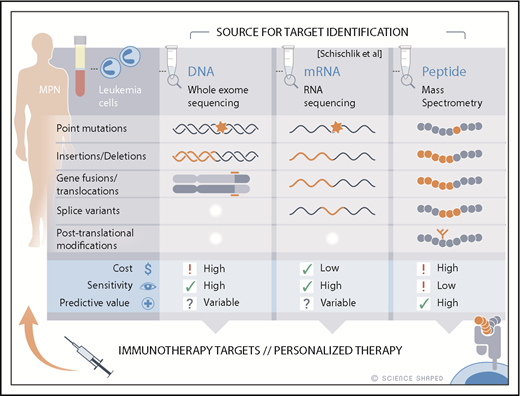In this issue of Blood, Schischlik et al describe a streamlined analysis of the granulocyte transcriptome (ie, messenger RNA [mRNA]) of 113 patients with myeloproliferative neoplasms (MPNs) to detect potential targets for immunotherapy.1
Detection of neoantigens (complexes of altered peptides and HLA molecules). DNA sequencing yields information about changes in the amino acid composition that arise from somatic mutations, insertions, deletions, and translocations (gene fusions). Schischlik et al show that mRNA sequencing provides similar results plus additional information about splice variants that arise from mutations in genes encoding mRNA splicing factors. Direct identification of neoantigens involves elution of peptides from HLA molecules and sequencing by MS. A unique feature of MS is the ability to detect peptides with tumor-specific posttranslational modifications such as phosphorylation.
Detection of neoantigens (complexes of altered peptides and HLA molecules). DNA sequencing yields information about changes in the amino acid composition that arise from somatic mutations, insertions, deletions, and translocations (gene fusions). Schischlik et al show that mRNA sequencing provides similar results plus additional information about splice variants that arise from mutations in genes encoding mRNA splicing factors. Direct identification of neoantigens involves elution of peptides from HLA molecules and sequencing by MS. A unique feature of MS is the ability to detect peptides with tumor-specific posttranslational modifications such as phosphorylation.
Modern DNA sequencing has redefined the diagnosis of MPNs from being based on descriptive morphologic and clinical features to being based on molecular characteristics. Approximately 90% of patients have disease-driving mutations in the JAK2, CALR, or MPL genes.2 The characterization of these mutations has provided insight into the pathophysiology of MPNs and has led to new therapies. Notably, the JAK2 inhibitor ruxolitinib ameliorates symptoms by reducing splenomegaly.3 Despite these advances, allogeneic stem cell transplantation is still the only curative treatment.
It is well established that T cells in stem cell grafts kill neoplastic cells, and complete remissions after donor-lymphocyte infusions is strong evidence that T-cell–based immunotherapy can be curative.4 The challenge is to specifically direct the attack to the malignant cells to avoid harmful effects on healthy tissue. Ultimately, this depends on the ability to identify HLA-peptide complexes that are specific for neoplastic cells (neoantigens). The most direct approach involves peptide elution from HLA and sequencing by mass spectrometry (MS) (see figure). There have been great advances in MS-based neoantigen detection during the past decade, and the most sophisticated workflows even allow interrogation of amino acid modifications such as phosphorylation.5
However, MS is complex, and the sensitivity is limited. It is therefore common to rely on DNA sequencing to identify neoantigens indirectly6 (see figure). By comparing sequencing results from neoplastic cells with those from healthy cells, somatic mutations that encode altered peptides can be identified. Additional analysis of mRNA yields information about expression levels, and computer algorithms that predict peptide binding to HLA are useful for selecting candidates that are likely to be immunogenic.6
Schischlik and colleagues show that analysis of mRNA from MPN granulocytes yields sufficient information about HLA haplotype and the mutational landscape to predict neoantigens for 62% of patients. This technique is a significant simplification compared with established methods, and the authors performed a number of control experiments to validate their approach. Analysis of mRNA from 20 patients with well-characterized cytogenetic aberrations confirmed that gene fusions were correctly identified. The authors also sequenced DNA from 77 patients to verify the precision for mRNA-based detection of somatic mutations. Finally, they generated synthetic peptides from candidate sequences and confirmed that many bind strongly to recombinant HLA molecules. Thus, the study is exceptionally thorough.
What can we learn from a systematic attempt to identify neoantigens in 113 MPN patients? First of all, it is reassuring that this study confirmed and extended earlier results showing that calreticulin mutations give rise to candidate neoantigens in patients with essential thrombocythemia or primary myelofibrosis (PMF).7 The most intriguing new finding is that mutations in the mRNA splicing factor SF3B1 in PMF yields several mRNAs that encode altered peptides. Many of the aberrantly spliced peptides were predicted to bind strongly to HLA, and results from in silico analysis were confirmed by experiments in which synthetic peptides were tested for binding to recombinant HLA molecules. The finding is particularly interesting in view of a recent report showing that mutations in genes encoding mRNA splicing proteins are associated with immune responses in solid tumors.8 Thus, there is a clear rationale for pursuing transcriptomics analysis in searches for candidate neoantigens in a wide range of neoplasms.
The most frequent mutation in MPN (JAK2-V617F) was not identified as a candidate neoantigen. This may seem surprising, given the results from a recent study showing that HLA-A2/JAK2-V617F is immunogenic.9 The explanation is that the prediction algorithm used by Schischlik et al does not identify the altered peptide as an HLA binder. This illustrates the limitation of indirect approaches (see figure). The good news is that the list of potential targets for immunotherapy of MPNs may be longer than the one published here. For example, it seems possible that cells that harbor the JAK2-V617F mutation contain aberrantly phosphorylated peptides. Thus, the next logical step is to use mRNA- and MS-based methods in parallel to determine whether the combination allows more sensitive and precise detection of neoantigens than either method used alone.
Conflict-of-interest disclosure: J.O. has a research collaboration with Kite Pharma and is a member of the Scientific Advisory Board of Intellia Therapeutics. F.L.-J. declares no competing financial interests.



